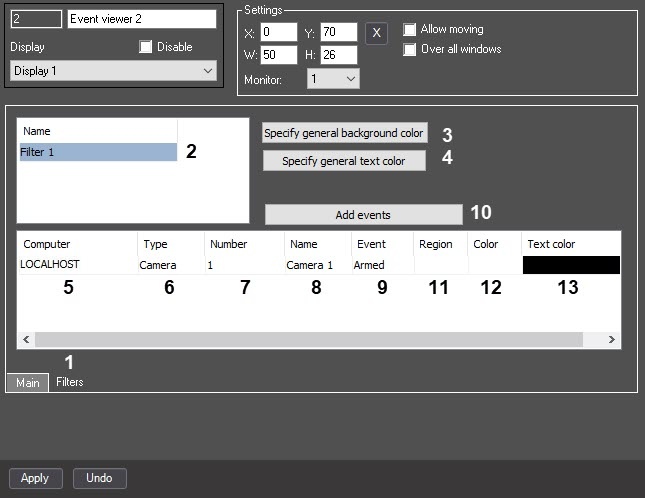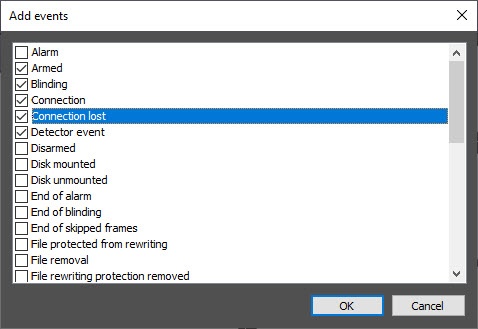
Go to documentation repository
Page History
To select the events that are to be logged in the the Events viewer interface object object, do the following:
- Go to the Filters tab tab (1) on the settings panel of the Event viewer object (1).
Set filter name in In the Name field (2), enter the name of the filter.
By default , the filters are created with the name Filter1, Filter2, etc. are created. and so on. To add a new filter, select the end last line in the list of filters and click the “down” down arrow key on the keyboard.Info title Note The You can copy the created filters can be copied by selecting the filter name , using the Ctrl+C and Ctrl+V
Note title Attention! key combination.
To A blank filter (i.e. filter with blank columns) should be created in order to display all events for all system objects in the system in the Event viewer. All events are also displayed in the Event viewer when there is no filter at all. window, you can use one of two methods:
- Create an empty filter, leaving all filter fields blank.
- Do not create a filter.
Both options provide a full output of data. If you delete all previously created filters, the interface still has an empty filter will be left. When , which, when selected, it will display displays all events.
- To set the background color that will be is used by default for all filter events, click the Specify general background color (3) button and select the required color in the standard dialog box Color window.
The default background color is white. - To set the text color that will be is used by default for all filter events, click the the Specify general text color (4) button and select the required color in the standard dialog box Color window.
The default text color is black. - In From the Computer drop-down list in the Computer column (5), select the Computer object under on the basis of which the objects included in the filter are to must be created (5). If filtering by computer is not required or the required object is created not under isn't created on the basis of the Computer object, then the empty value is to be selected select a blank value in this drop-down list.
In From the drop-down list of in the Type column in the Objects tab(6), select the type of an object for which the required event may can be logged (6). If the field is empty, the Events viewer will display all the events for all the objects in the systemyou don't specify the type of an object, when you select this filter, all events of all objects are logged in the Event viewer.
Info title Note To activate You can open the drop-down list in the
Objects tab and in the Areas list, left-clicktable by double-clicking the left mouse button on the corresponding cell.
DetailedFor the detailed description of actions with
tabstables and lists
is in the, see Object settings panel.
- In From the drop-down list of in the Number column in the Objects tab, specify the ID for an object of the type (7), select the ID of the object, the type of which was selected in step 1 (7). If the field is emptyblank, the interface Events viewer will log object logs all events of the events object of the specified type.
- Object The name of the object isset automatically on the basis of the values selected in step 1-2 and displayed in the Number column of the Objects tab Name column (8). You can not cannot edit the Name column.
- In From the drop-down list of in the Event column of the Objects tab, specify the (9), select the required event for the selected object in step 1-2 (9). If the field is emptyblank, the interface Events viewer will log object logs all the events of registered for the specified typeobject.
- To add one or more events from the same object, proceed as followsdo the following:
- Select a line in which at least the type of object has already been selected.
- Click the Add events button (10).
- In the window that opens, check set the boxes checkboxes next to the required events.
- Click the OK button.
As a result, rows corresponding to the selected events are added to the table. All event settings, including colors and , IDs, object type and ID etc. , and so on, are copied from the original selected event.
- From the drop-down list in the Region column (11), select the Region to log events of objects included in this region. If the objects are identified (see step 7) or no region
- Region is set, then the
- events are recorded in the Event viewer object without taking into account the objects' belonging to the Region.
From the
logged without object’s belonging to any region.In the Color drop-down list select in the Color column (12), select the background color for the message about an event in the Event viewer (12)window.
- In From the Text color drop-down list in the Text color column (13), select the text color of the event message in the Event Viewer (13)viewer window.
Repeat steps 3-9 for all required objects and sections in the filter.
Repeat steps2-
1013 for all required
objects and regionsfilters.
- Click the Apply button to save all the changes.
Events Selecting events for logging to the Events viewer interface object are now selectedis complete.
| Tip |
|---|
...


